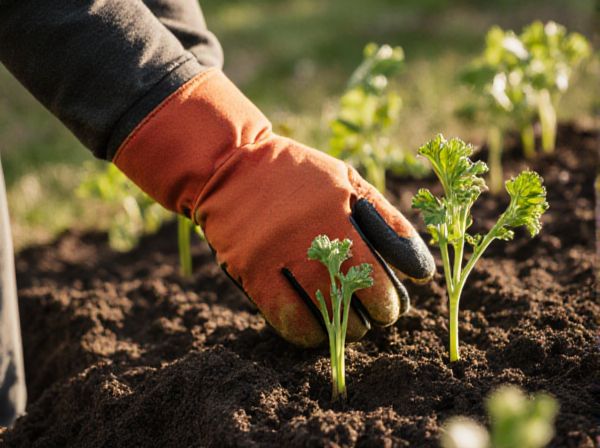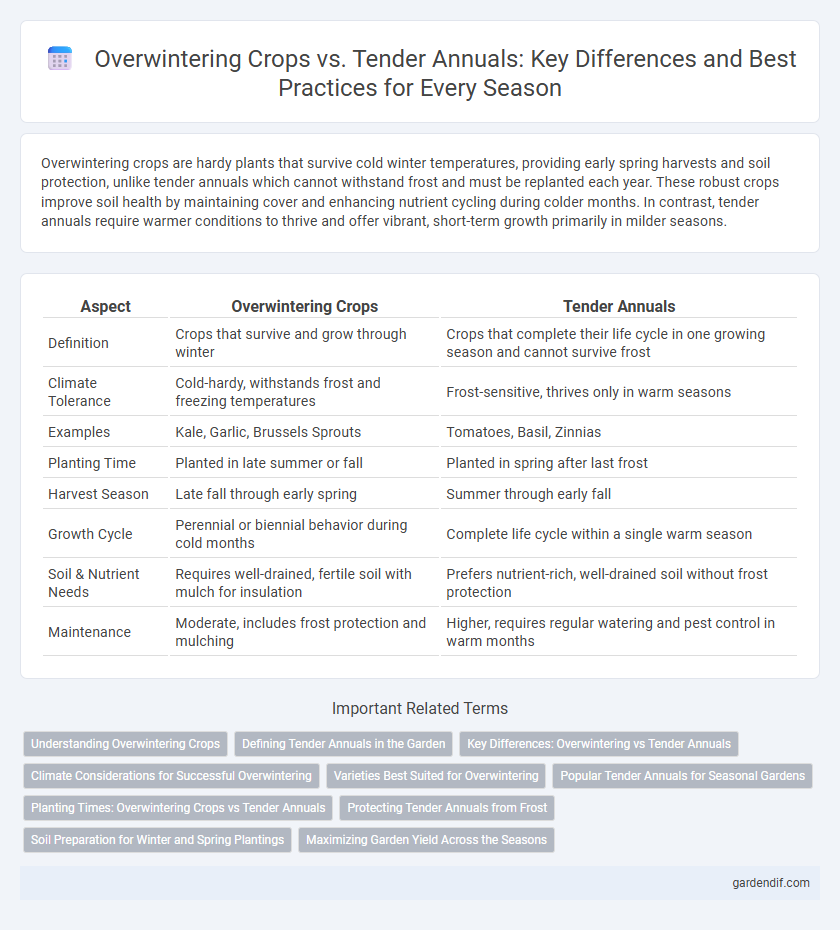
Overwintering crops vs Tender annuals Illustration
Overwintering crops are hardy plants that survive cold winter temperatures, providing early spring harvests and soil protection, unlike tender annuals which cannot withstand frost and must be replanted each year. These robust crops improve soil health by maintaining cover and enhancing nutrient cycling during colder months. In contrast, tender annuals require warmer conditions to thrive and offer vibrant, short-term growth primarily in milder seasons.
Table of Comparison
| Aspect | Overwintering Crops | Tender Annuals |
|---|---|---|
| Definition | Crops that survive and grow through winter | Crops that complete their life cycle in one growing season and cannot survive frost |
| Climate Tolerance | Cold-hardy, withstands frost and freezing temperatures | Frost-sensitive, thrives only in warm seasons |
| Examples | Kale, Garlic, Brussels Sprouts | Tomatoes, Basil, Zinnias |
| Planting Time | Planted in late summer or fall | Planted in spring after last frost |
| Harvest Season | Late fall through early spring | Summer through early fall |
| Growth Cycle | Perennial or biennial behavior during cold months | Complete life cycle within a single warm season |
| Soil & Nutrient Needs | Requires well-drained, fertile soil with mulch for insulation | Prefers nutrient-rich, well-drained soil without frost protection |
| Maintenance | Moderate, includes frost protection and mulching | Higher, requires regular watering and pest control in warm months |
Understanding Overwintering Crops
Overwintering crops, such as kale, garlic, and Brussels sprouts, are hardy plants designed to survive cold winter temperatures and continue growing through the season. Unlike tender annuals that perish with the first frost, overwintering crops increase yield reliability and extend harvest periods in temperate climates. Gardeners optimize soil preparation and use protective mulch to enhance plant resilience and maximize nutrient retention during winter months.
Defining Tender Annuals in the Garden
Tender annuals are plants that complete their life cycle within one growing season but lack the hardiness to survive cold winter temperatures. Unlike overwintering crops such as kale or Brussels sprouts, tender annuals like impatiens and basil require protection from frost and cannot withstand freezing conditions. Gardeners must plant tender annuals after the last frost date and treat them as seasonal bedding plants due to their sensitivity to cold and inability to overwinter outdoors.
Key Differences: Overwintering vs Tender Annuals
Overwintering crops, such as kale and spinach, survive cold temperatures by entering a dormancy phase, enabling them to grow through winter and improve in flavor after frost exposure. Tender annuals like tomatoes and peppers complete their life cycle in one growing season and cannot tolerate freezing conditions, requiring harvest before the first frost. Key differences include cold tolerance, life cycle duration, and planting time, with overwintering crops planted late in the season for winter harvest and tender annuals grown in frost-free warmer months.
Climate Considerations for Successful Overwintering
Overwintering crops thrive in climates with mild winters and well-drained soil, as they require protection from extreme frost and prolonged freezing temperatures. Tender annuals, however, demand warmer climates or indoor environments during cold seasons to prevent damage and ensure survival. Understanding regional temperature ranges and frost dates is crucial for selecting appropriate species and applying protective measures like mulching or row covers.
Varieties Best Suited for Overwintering
Overwintering crops such as kale, spinach, and garlic have cold-hardiness traits that enable them to survive frost and low temperatures, unlike tender annuals like tomatoes and peppers which require warm conditions. Varieties best suited for overwintering include 'Winterbor' kale, 'Bloomsdale' spinach, and softneck garlic, all known for their resilience and ability to mature in cold climates. Selecting these cultivars ensures a reliable harvest during winter months, enhancing food security in cold-season gardening.
Popular Tender Annuals for Seasonal Gardens
Popular tender annuals for seasonal gardens include petunias, impatiens, and marigolds, known for their vibrant colors and continuous blooming throughout warm months. These plants thrive in frost-free environments and typically require replanting each year since they cannot survive winter cold. Gardeners often choose tender annuals to enhance garden aesthetics with diverse hues and textures before transitioning to overwintering crops in the colder season.
Planting Times: Overwintering Crops vs Tender Annuals
Overwintering crops are typically planted in late summer to early fall, allowing them to establish before winter and thrive through cold temperatures. Tender annuals require planting after the last frost, usually in spring, as they are sensitive to freezing conditions and need warmer soil to grow. Timing these plantings correctly maximizes growth and yield by aligning with each crop's temperature tolerance and seasonal needs.
Protecting Tender Annuals from Frost
Tender annuals require diligent frost protection techniques to survive overwintering in temperate climates, as they lack the hardiness of overwintering crops like kale or Brussels sprouts. Utilizing methods such as mulching, frost cloths, or moving containers indoors can shield these sensitive plants from freezing temperatures and frost damage. Maintaining soil warmth and moisture levels also enhances the resilience of tender annuals during cold spells.
Soil Preparation for Winter and Spring Plantings
Preparing soil for overwintering crops requires thorough tilling and the addition of organic compost to improve moisture retention and nutrient availability during cold months. Tender annuals demand well-drained, frost-free soil enriched with balanced fertilizers to support early spring growth. Both approaches benefit from mulching to regulate soil temperature and prevent erosion, ensuring optimal conditions for winter and spring plantings.
Maximizing Garden Yield Across the Seasons
Overwintering crops such as kale, spinach, and Brussels sprouts thrive in cold temperatures, extending the growing season and ensuring continuous harvest during winter months. Tender annuals like tomatoes, peppers, and basil flourish in warmer conditions but require protection or replanting each year, limiting their productivity to the frost-free season. Integrating both crop types strategically maximizes garden yield by providing fresh produce throughout the year while optimizing space and soil resources.
Overwintering crops vs Tender annuals Infographic

 gardendif.com
gardendif.com